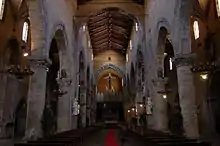San Francesco d'Assisi, Palermo
The Church of Saint Francis of Assisi (Italian: Chiesa di San Francesco d'Assisi or simply San Francesco d'Assisi) is an important church of Palermo. It is located near the main street of the city, the ancient Cassaro, in the quarter of the Kalsa, within the historic centre of Palermo. The building represents the main Conventual Franciscan church of Sicily. It has the title of Minor basilica.
| Church of Saint Francis of Assisi | |
|---|---|
Chiesa di San Francesco d'Assisi (in Italian) | |
 Façade of the Church of Saint Francis | |
| Religion | |
| Affiliation | Roman Catholic |
| Province | Archdiocese of Palermo |
| Rite | Roman Rite |
| Location | |
| Location | Palermo, Italy |
| Geographic coordinates | 38°06′59.44″N 13°21′59.32″E |
| Architecture | |
| Style | Gothic, Sicilian Baroque |
| Groundbreaking | 13th century |
| Website | |
| Official site | |

History
The history of the church starts with the arrival of the first Franciscans in Sicily. In 1224 the chronicler Vadingo reported the groundwork of the first Franciscan convent near the Walls of Palermo. However, shortly after, the local clergy with the support of the Saracens chased the friars out from the city. The friars went to Viterbo and appealed to the Pope Gregory IX.
The pontiff ordered Landone, archbishop of Messina, to promote the reconstruction of the convent. In this way the pope took advantage of the absence of Berard of Castagna, archbishop of Palermo gone to Germany with the Emperor Frederick II. Therefore, in 1235 the friars built a new convent by converting an old Byzantine fortification dating back to the military campaign of George Maniakes. In 1239, because of quarrels with the Pope, Frederick II decreed the building's destruction.
In 1255 the Vicar general of Sicily Ruffino Gorgone da Piacenza, chaplain of Pope Alexander IV, entrusted the reconstruction to the bishop of Malta, Roger. The work went on during the period of Charles of Anjou. In 1302 the main portal and the anterior façade were built, both in Chiaramontan-Gothic style. In the 15th century several chapels were built in Gothic and Renaissance style, including the Chapel Mastrantonio, the first manifestation of the Renaissance in Sicily.
Over the centuries the church became rich of artworks thanks to artists like Antonio di Belguardo, Antonio Scaglione, Giuseppe Giacalone, Francesco Laurana, Pietro de Bonitate, Gabriele di Battista, Domenico Pellegrino, Iacopo de Benedetto, Domenico Gagini, Antonello Gagini, Antonio Gagini, Giacomo Gagini, Giuliano Mancino, Antonio Berrettaro, Antonello Crescenzio, Cesare da Sesto, Mariano Smiriglio, Vincenzo degli Azani, Pietro Novelli, Gerardo Astorino and Giacomo Serpotta. As a result, the church represents a mix of different styles, mainly Gothic and Sicilian Baroque.
On 5 March 1823 the building was damaged by an earthquake. The church was restored in the Neoclassical style. Other damages were caused by the air raids during the Second world war. In recent decades the church was restored.
In 1924 Pope Pius XI gave the title of Minor basilica to this building. The church of Saint Francis of Assisi has an important role in the religious life of Palermo: in fact, in this church is enshrined the Simulacrum of the Immaculate Conception that every year, on the evening of December 8, pass through the streets of the historic center among thousands of believers who accompany the procession till the Piazza San Domenico.[1]
Gallery
 Portal
Portal Chapel of the Immaculate Conception
Chapel of the Immaculate Conception Chapel of Saint Francis
Chapel of Saint Francis Chapel of Saint George
Chapel of Saint George Chapel Mastrantonio
Chapel Mastrantonio Simulacrum of the Immaculate Conception
Simulacrum of the Immaculate Conception
See also
| Wikimedia Commons has media related to San Francesco d'Assisi (Palermo). |
- Kalsa
- Oratorio di San Lorenzo
- Oratorio dell'Immacolatella